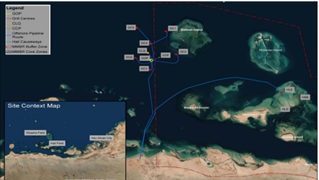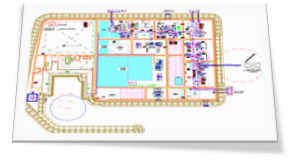AUTHOR: Hachemi Nassima
TUTORS: Dott.ing. GIOVANNI Franchi, ing. MARIA ROSA Olocco
INTERNSHIP: Saipem SPA, Milano
MASTER: Master in “Project management in construction works with BIM” a.a 2023/24
Questo lavoro di tesi è stato svolto durante il periodo di stage presso la società Saipem SPA a seguito della frequentazione del master project management in construction works with BIM,
Il raggiungimento del successo di qualsiasi commessa risulta essere condizionato da molti fattori sia interni che esterni all’organizzazione.
La conoscenza delle linee guida e delle pratiche del project management può contribuire in modo sostanziale a gestire e monitorare il progetto sin dalle sue fasi iniziali.
Il BIM è certamente un’impattante realtà di mercato, oggi inevitabile come all’incirca metà degli anni ’80 lo fu il passaggio dalla matita al CAD o ancora ai nuovi metodi di progettazione agli elementi finiti FEM, risulta evidente la volontà del legislatore di allineare l’Italia all’Unione Europea e ai Paesi digitalmente più all’avanguardia recependo la direttiva appalti UE, facendo della digitalizzazione una normativa cogente e inserendola nel codice dei contratti pubblici grazie al D.M.2. di agosto 2021.n 312, rubricato “Modifiche al decreto del Ministero delle infrastrutture e dei trasporti 1° dicembre 2017, n. 560, anche conosciuto come Decreto Baratono”, che innova ed integra il D.M.560/2017 e soddisfa la previsione dell’art .48, comma 6 del D.L 77/2021 convertito senza modificazioni con la legge n.108/2021. Il DL 36 31_03_2023 Codice appalti art 43 _metodi e strumenti di gestione informativa digitale delle costruzioni Comma1, afferma che a decorrere dal 1° gennaio 2025, le stazioni appaltanti e gli enti concedenti adottano metodi e strumenti di gestione informativa digitale delle costruzioni per la progettazione e la realizzazione di opere di nuova costruzione e per gli interventi su costruzione esistenti per importo a base di gara superiore a 1 milione di euro.
L’oggetto del presente elaborato si pone come primo obiettivo la gestione di una commessa BIM all’interno di Saipem SPA (caso studio: edificio stick built “GOP main harbour and CICPA gate house” all’interno dell’area Gop del progetto Hail and Ghasha development ) usando gli strumenti del project management richiamate sia dalle norme UNI ISO 21500 e UNI ISO 21502 sia dalle linee guida del PMBOK (Project Management Body of Knowledge), evidenziando le migliorie che apporterebbe, non solo in termini di tempi, costi e qualità ma anche in termini di risorse umane.
Il caso studio incomincia con la stesura di un documento vitale, il business case, attività che fa parte delle attività pre-progetto e che illustra i benefici quali-quantitativi della commessa.
Il business case fornisce una base per la governance del progetto, ma ne giustifica anche l’avvio e la prosecuzione. Dopo aver deciso di avviare il progetto sulla base del business case si passa alla definizione del project charter che ufficializza formalmente l’esistenza del progetto e fornisce l’autorità per utilizzare le risorse per le attività del progetto.
La SWOT Analysis (Strength “Punti di forza”, Weaknesses “Punti di debolezza”, Opportunities “Opportunità”, Threats “Minacce”) è uno strumento utile che consente di valutare eventuali rischi a livello alto, per poi definirli più specificatamente nell’analisi dei rischi. Le quattro variabili prese in analisi vengono rappresentate attraverso la matrice dei rischi mettendoli a sistema con ciò che può essere utile al conseguimento dell’obiettivo e con ciò che invece può essere dannoso.
La gestione del rischio dall’identificazione e la valutazione alla mitigazione, ci consente pertanto di visualizzare e prendere maggiore coscienza del progetto che si va ad affrontare, ponendo delle questioni sui profili di rischio per le attività, che andrebbero eliminati o mitigati con delle misure di contenimento.
Il primo step della pianificazione è stato quello della creazione di una WBS (Work Breakdown Structure) di progetto andando a scandire tutte le attività necessarie per gestire la commessa. Successivamente, è stata prodotta una Organization Breakdown Structure di progetto, associando ad ogni attività precedentemente schedulata una risorsa specifica.
Il caso studio prosegue con la creazione della Raci Matrix e l’adozione delle best practice del project management descritti nel PMBOOK (PERT, CPM, GANTT) per una gestione migliore dei tempi.
Nella fase dell’esecuzione viene descritto lo sviluppo della metodologia BIM per il caso studio, con la realizzazione dei modelli digitali tridimensionali parametrici in grado di fornire specifiche informazioni inerenti a tutti gli elementi che li compongono seguendo quanto scritto nel BEP post contract. In questa fase viene eseguita l’esportazione dal formato proprietario al formato aperto interoperabile del modello tridimensionale di tutte le discipline per eseguire le Clash detection e la creazione del modello federato usando navisworks manage. Nel seguito vengono individuate le interferenze e vanno risolte tutte gli Issues. Vengono estratte le DWGP e le BOQ e viene inserito il modello dell’edificio nel modello dell’impianto.
La commessa si conclude con la valutazione sull’operato al fine di generare conoscenza per migliorare la pianificazione futura. Preparare una close out project review con gli stakeholders interni per presentare i risultati del progetto è essenziale evidenziando non solo i successi ma anche i fallimenti che ci sono stati e sottolineare le cose da non ripetere e le cose da cui è possibile trarre un vantaggio immediato su altri progetti. Tutto questo viene redatto nel lesson learned register.
Le tecniche del miglioramento continuo sono usate a grande linea all’interno di Saipem SPA per ottimizzare la produzione aziendale riducendo lo spreco di risorse e tempo. Nella tesi viene applicato il ciclo di Deming alla commessa caso studio.
Area GOP e l’ubicazione dell’edificio CICPA
FOR INTERNATIONAL STUDENTS
This thesis work was carried out during the internship period at the Saipem SPA company following attendance of the master project management in construction works with BIM, Achieving the success of any project is conditioned by many factors both internal and external to the organization. Knowledge of project management guidelines and practices can substantially contribute to managing and monitoring the project from its initial stages. BIM is certainly an impactful market reality, today as inevitable as the transition around the mid-1980s from pencil to CAD or to the new FEM finite element design methods, the legislator’s desire to align Italy to the European Union and to the most digitally advanced countries by implementing the EU procurement directive, making digitalization a mandatory legislation and inserting it into the public contracts code thanks to Ministerial Decree 2. of August 2021.n 312, entitled “Amendments to the decree of the Ministry of Infrastructure and Transport 1 December 2017, n. 560, also known as the Baratono Decree”, that innovates and integrates the Ministerial Decree 560/2017 and satisfies the provisions of art. 48, paragraph 6 of the Legislative Decree 77/2021 converted without modifications with law n.108/2021. Legislative Decree 36 31_03_2023 Procurement Code art 43 _methods and tools for digital information management of constructions Comma1, states that starting from 1 January 2025, contracting authorities and granting bodies shall adopt methods and tools for digital information management of constructions for the design and the implementation of new construction works and for interventions on existing buildings for a tender amount exceeding 1 million euros.
The object of this paper has as its first objective the management of a BIM order within Saipem SPA (case study: stick built “GOP main harbour and CICPA gate house” within the Gop area of the Hail and Ghasha development project) using the project management tools referred to both by the UNI ISO 21500 and UNI ISO 21502 standards and by the PMBOK (Project Management Body guidelines of Knowledge), highlighting the improvements it would bring, not only in terms of time, costs and quality but also in terms of human resources. The case study begins with the drafting of a vital document, the business case, an activity which is part of the pre-project activities, and which illustrates the qualitative and quantitative benefits of the order.
The business case provides a basis for the governance of the project, but also justifies its initiation and continuation. After deciding to start the project on the basis of the business case, we move on to the definition of the project charter which formally formalizes the existence of the project and provides the authority to use the resources for the project activities.
The SWOT Analysis (“Strengths”, “Weaknesses”, “Opportunities”, “Threats”) is a useful tool that allows you to evaluate any risks at a high level, and then define them more specifically in the analysis of risks. The four variables taken into analysis are represented through the risk matrix, placing them in a system with what can be useful for achieving the objective and with what can instead be harmful. Risk management from identification and evaluation to mitigation therefore allows us to visualize and become more aware of the project we are going to face, raising questions about the risk profiles for the activities, which should be eliminated or mitigated with containment. The first planning step was the creation of a project WBS (Work Breakdown Structure), breaking down all the activities necessary to manage the order. Subsequently, a project Organization Breakdown Structure was produced, associating each previously scheduled activity with a specific resource. The case study continues with the creation of the Raci Matrix and the adoption of the project management best practices described in the PMBOOK (PERT, CPM, GANTT) for better time management.
In the execution phase, the development of the BIM methodology for the case study is described, with the creation of parametric three-dimensional digital models capable of providing specific information relating to all the elements that compose them following what is written in the post contract BEP. In this phase, the three-dimensional model of all disciplines is exported from the proprietary format to the interoperable open format to perform clash detections and create the federated model using navisworks manage. Below, interferences are identified, and all issues must be resolved. The DWGP and BOQ are extracted, and the building model is inserted into the system model.
The contract concludes with an evaluation of the work in order to generate knowledge to improve future planning. Preparing a close out project review with internal stakeholders to present the results of the project is essential by highlighting not only the successes but also the failures that have occurred and underlining the things not to be repeated and the things from which it is possible to draw an immediate advantage on other projects. All this is written down in the lesson learned register.
Continuous improvement techniques are widely used within Saipem SPA to optimize company production by reducing waste of resources and time. In the thesis the Deming cycle is applied to the order case study.


